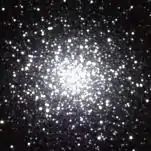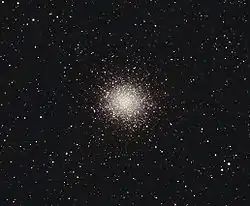| M14 | |
|---|---|
 Messier 14, from 2MASS | |
| Observation data (J2000 epoch) | |
| Class | VIII |
| Constellation | Ophiuchus |
| Right ascension | 17h 37m 36.15s[1] |
| Declination | -03° 14′ 45.3″[1] |
| Distance | 30.3 kly (9.3 kpc) |
| Apparent magnitude (V) | +8.32[1] |
| Apparent dimensions (V) | 11.0′ |
| Physical characteristics | |
| Mass | - kg (- M) |
| Radius | 50 ly[2] |
| VHB | - |
| Estimated age | - |
| Notable features | - |
| Other designations | NGC 6402[1] |
Messier 14 (also known as M14 or NGC 6402) is a w:globular cluster in the w:constellation w:Ophiuchus. It was discovered by w:Charles Messier in w:1764.
At a distance of about 30,000 light-years, M14 contains several hundreds of thousands of w:stars. At an w:apparent magnitude +7.6 it can be easily observed with w:binoculars. Medium-sized w:telescopes will show some hint of the individual stars of which the brightest is of magnitude +14.
The total w:luminosity of M14 is in the order of 400,000 times that of the w:Sun corresponding to an w:absolute magnitude of -9.12. The shape of the cluster is decidedly elongated. M14 is about 100 light-years across.
A respectable total of 70 w:variable stars is known in M14, many of the W Virginis variety common in globular clusters. In w:1938, a w:nova appeared although this was not discovered until w:photographic plates from that time were studied in w:1964. It is estimated that the nova reached a maximum brightness of magnitude +9.2, over five times brighter than the brightest 'normal' star in the cluster.
Slightly over 3° southwest of M14 lies the faint globular cluster NGC 6366.

External links
References
- 1 2 3 4 "SIMBAD Astronomical Database". Results for NGC 6402. http://simbad.u-strasbg.fr/Simbad. Retrieved 2006-11-15.
- ↑ distance × sin( diameter_angle / 2 ) = 50 ly. radius
| |||||